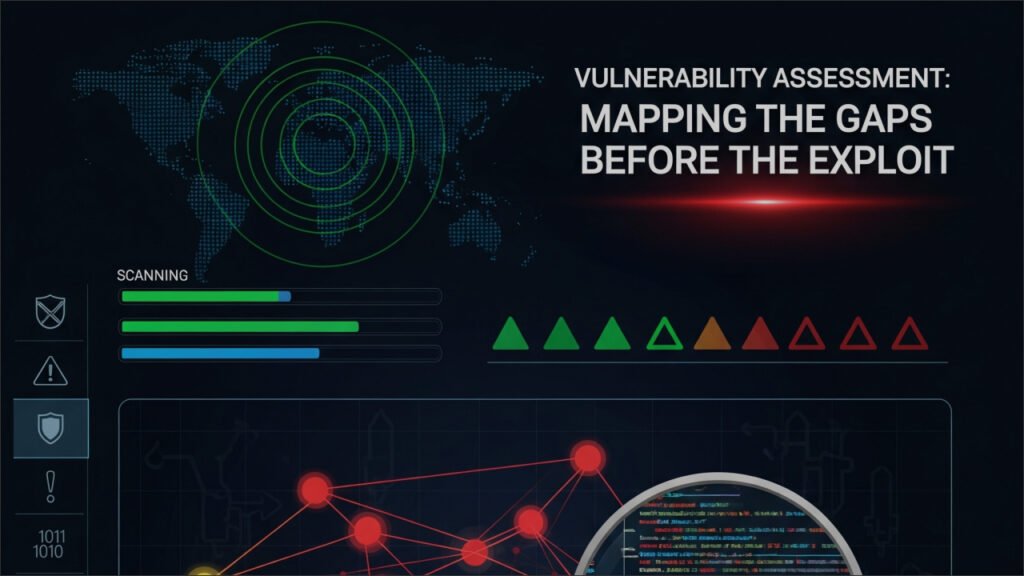Trace the crack, trigger the flaw—before someone else does.
Vulnerability Assessment isn’t about attacking—it’s about analyzing, predicting, and preventing. Think of it as reading the blueprint before deciding where a thief might enter. For ethical hackers and bug hunters, this phase isn’t just pre-attack recon—it’s a mindset. You’re not here to break things yet. You’re here to identify what could break and how devastating it would be if someone else found it first.
Let’s step into the world of modern vulnerability assessments, designed not just for compliance but for real-world offense-minded defense.
Table of Contents

CVE Scanning: Reading the Known, Finding the Ignored
Start with what the world already knows—CVEs (Common Vulnerabilities and Exposures). But don’t just run a scanner and call it a day. Think deeper:
- Are there CVEs affecting software that shouldn’t even be there?
- Is outdated software running silently behind obscured ports?
- Are patches applied, or do they just exist in documentation?
It’s like flipping through a rogue’s gallery, wondering, “Is this outdated gear on the hit list?” A scan flags an unpatched OpenSSL 1.0.2 with CVE-2016-2107, hinting at a data leak risk. The next move? Check server logs or configs to confirm it’s active. Link this with misconfiguration detection to show an exposed port makes it worse
Use scanners as guides, not gospel. Combine their findings with manual verification and logic. A good hacker reads CVE reports like a detective reads cold cases.
Web Vulnerability Scanning: Digging into Web Cracks
Most devs think a scan with OWASP ZAP or Burp equals security. But real attackers know better.
- Do the scanners identify all input points? (Look for hidden fields, dynamic JS-injected forms)
- Are headers properly set (e.g., CSP, HSTS, X-Content-Type)?
- Is there any strange behavior on POST vs GET requests?
It’s a scavenger hunt through a site’s backyards, asking, “What snaps if I nudge this?” A scan catches a stored XSS in a comment box, echoing . The smart play? Tie it with API vulnerability testing to see if the flaw spreads to linked endpoints, turning a minor bug into a multi-layer exploit with bounty potential.
Use scans to get the overview—but validate every result manually. The scanner is your scalpel, not your sword.
API Vulnerability Testing: The Silent Gateways
APIs are the arteries of modern apps—and often the least secured. Vulnerability assessment here involves both static checks and logical testing:
- Are API keys or tokens exposed in requests or responses?
- Is there versioning? Can you access v1, v2, or even deprecated endpoints?
- Is the API returning too much data, or does it lack proper access control?
It’s like sneaking around a back entrance, wondering, “What’s this API leaving open?” A test spots /user/profile dumping full records without a login check. Digging further, linking this with access control testing reveals admins can snatch anyone’s data, escalating it into a privacy nightmare.
Think like a developer who reuses endpoints without second thought—and then find where that convenience creates chaos.
CMS Vulnerability Scanning: The Forgotten Admin Panels
WordPress, Joomla, Drupal—they’re everywhere. And so are their flaws.
- Are plugins up-to-date? Are they even necessary?
- Is there a forgotten admin.php panel from a developer’s staging phase?
- Can you guess the login route? Many CMSs follow predictable patterns.
It’s a stakeout at a CMS party, asking, “What did they forget to update?” A scan flags a Drupal 7.5 with a plugin hit by CVE-2018-7600. The next step? Pair it with web vulnerability scans to test if the plugin’s forms leak data, turning a patchable gap into a live threat.
A bug hunter doesn’t just check CVEs; they investigate integrations, theme injections, and third-party plugin logic.
Misconfiguration Detection: The Invisible Menace
The most dangerous flaws are the ones that aren’t “bugs”—they’re bad setups.
- Publicly accessible dev environments
- Missing authentication on internal tools
- Insecure CORS or overly permissive APIs
- Default credentials still in use
It’s a home inspector’s hunch, wondering, “Did they leave a door ajar?” A scan finds a MongoDB instance with no auth, spilling database contents. Linking this with access control testing shows who can tweak settings, building a fix-it case for a data spill.
Misconfigurations often lead to privilege escalation, lateral movement, or total compromise. Think like an attacker who’s not exploiting code but exploiting trust.
Access Control Testing: Guarding the Crown Jewels
Access control isn’t just about roles—it’s about logic, predictability, and what’s left unguarded.
- Can a normal user access admin data by changing a user ID?
- Is horizontal or vertical privilege escalation possible?
- Are sensitive endpoints protected by anything beyond obscurity?
It’s a spy testing fences, asking, “Can this user sneak into the VIP area?” A test swaps a user ID from 100 to 101 and unlocks another account. Chain this with CVE scans to find an old library enabling the bypass, turning a permissions slip into a high-stakes report.
Push the system like an insider with limited access who wants more. That’s how attackers think—and how you should test.
Conclusion: You’re Not Just Scanning, You’re Simulating
Vulnerability assessment isn’t a checkbox. It’s a layered, logical, adversarial process. You’re not just searching for what’s broken—you’re searching for what will break, given the right pressure.
Whether you’re preparing a red team op, running an internal pentest, or contributing to a bug bounty program, remember this:
Vulnerability assessment is reconnaissance with teeth. Do it right, and you won’t just find weaknesses—you’ll understand their impact.


